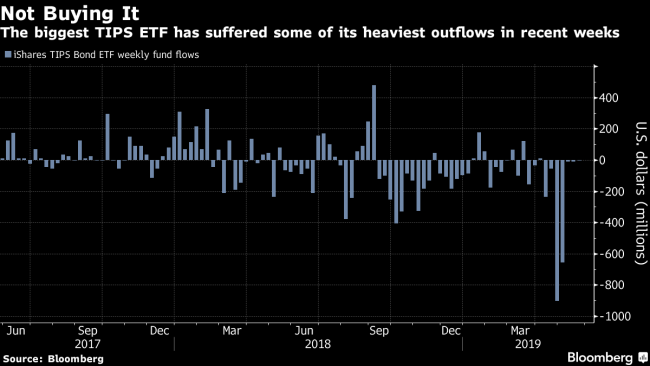(Bloomberg) -- When it comes to inflation, the Federal Reserve seems to want the market to expect the unexpected.
Investors don’t foresee consumer price pressures building any time soon. That’s the message from how inflation-linked U.S. government debt is trading and the record-breaking amount that was just yanked out of the iShares TIPS Bond ETF, a fund that holds Treasury Inflation-Protected Securities.
This is a problem for Fed policy makers trying to fulfill their duty to maintain price stability, since they believe inflation expectations are a leading driver of actual inflation. And sagging inflation increases pressure on the Fed to cut interest rates, something they’re not inclined to do at the moment.
Minutes from the Fed’s April 30-May 1 meeting, which were published Wednesday, confirmed many officials agreed with Chairman Jerome Powell’s description of a recent downdraft in U.S. inflation as “transitory.” But several also flagged “a risk that inflation expectations could become anchored” too low, “a development that could make it more difficult to achieve the 2% inflation objective on a sustainable basis over the longer run.”
Since consumer price gains have been lagging the Fed’s 2% target for much of the past decade, it’s little wonder that inflation isn’t a hot topic in the market yet. But it may be warming up, with the Fed actively debating how it can meet its inflation goals, including a June 4-5 conference to discuss different approaches.
Fed Pushback
“These inflation expectations built into the market, the Fed’s going to push back. They’re just too low,” said Thanos Bardas, global co-head of investment grade at Neuberger Berman, which manages $323 billion in assets.
It’s been argued over the past decade that enduring forces such as aging demographics, technological advances and shifting labor trends have ushered in a new world of low inflation, but a lot is happening right now that could help reshape the outlook. That includes tightening supply in the oil market, rising wages and tariffs.
Lindsay Politi at One River Asset Management is among portfolio managers who believe the market is underestimating price pressures as a result of escalating trade disputes. Market-implied inflation expectations fell further on news of additional tariffs by the U.S. and China, because investors focused on the tax to consumers, and a threat to the global economy. Politi is focusing on the likely bump in consumer prices, and a buying opportunity in TIPS.
“For me what’s most interesting is that the tariff risk is really being priced in only as a growth risk and not as an inflation risk right now,” said Politi, who manages global inflation-linked portfolios.
Breakeven Rates
Current market pricing reflected in the so-called breakeven rate -- a measure derived from the difference between inflation-linked debt and other Treasuries -- implies that the consumer price index will remain below 2% over the next five years.
Politi says the skew toward consumer products in this latest round of tariffs could lift U.S. CPI growth by around 25 basis points. The spread of protectionist trade policy is more likely to boost than to mitigate price pressures, she said.
“One could view these tariffs as a series of one-off events, or one could view them as part of a general trend globally toward nationalism,” she said. That shift would make “economies on the margin less efficient and more prone to inflation,” she added.
Eric Rosengren, president of the Boston Federal Reserve, expressed similar thoughts Tuesday on the near-term effect of tariffs, saying they could boost inflation back to the 2% target faster than expected. That might take some pressure off policy makers next month as they debate a better way to manage price pressures, but it’s unlikely to let them off the hook.
Less Room
Cutting interest rates to address stubbornly below-target inflation would leave the Fed even less room to maneuver with its main weapon to fight the next economic downturn. Subdued price pressures globally also raise fears that the developed world might be on the brink of a vicious cycle of soft demand and sluggish growth.
The June 4-5 conference will be important. Many Fed officials have described it as the centerpiece of the year-long review of monetary policy strategy that is currently underway. Potential alternatives to the current strategy of targeting 2% inflation include a “make-up” approach that would seek to push inflation higher at times to compensate for prior periods of weakness, or shifting from targeting a specific number to a wider range.
If the Fed ends up adopting a new strategy, “I would think it would get market expectations about future inflation to move higher,” said Neil Dutta, head of economics at Renaissance Macro Research. “If they don’t come back with anything, then I think that would be problematic, because it would suggest that they don’t really see their decade-long undershoot on inflation as being a problem.”
